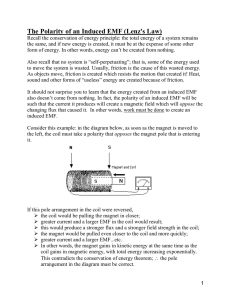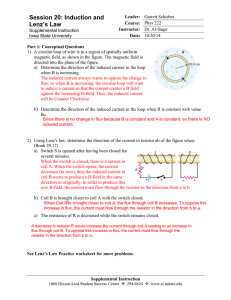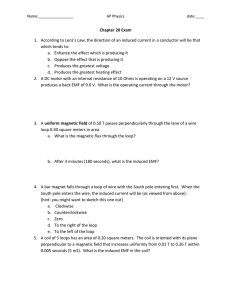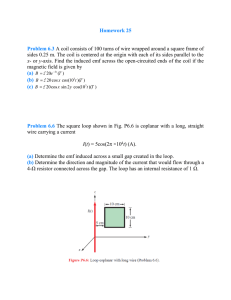PHY 201 In-Class Worksheet 04 Dec 2006 Lenz`s Law and Induced
advertisement
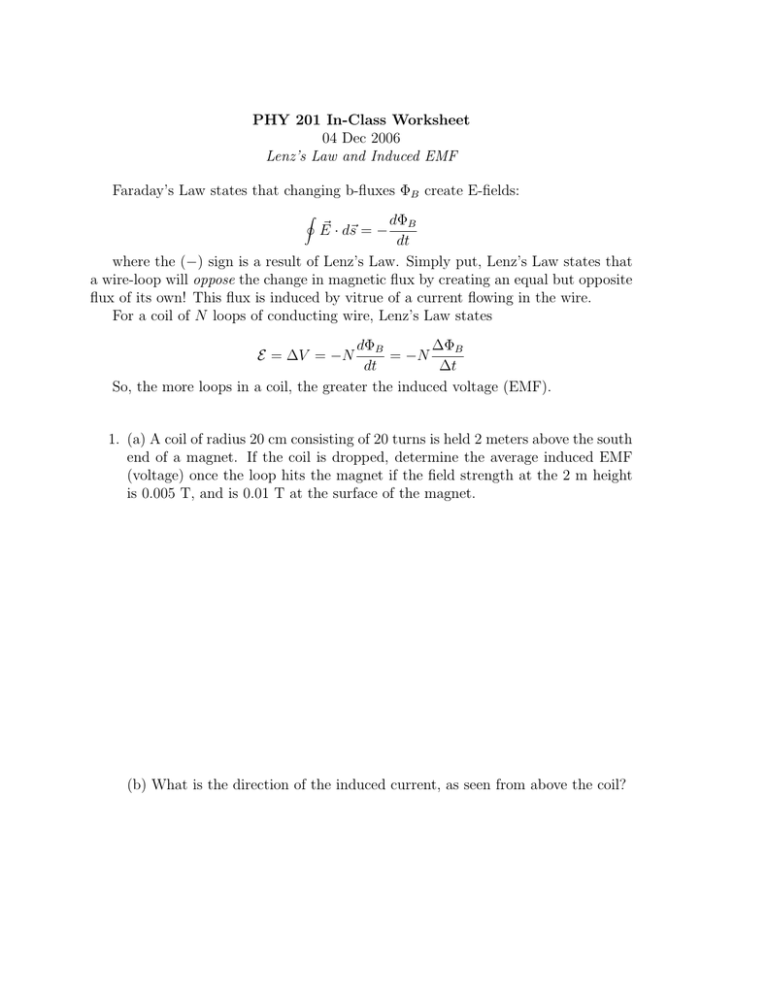
PHY 201 In-Class Worksheet 04 Dec 2006 Lenz’s Law and Induced EMF Faraday’s Law states that changing b-fluxes ΦB create E-fields: ~ · d~s = − dΦB E dt where the (−) sign is a result of Lenz’s Law. Simply put, Lenz’s Law states that a wire-loop will oppose the change in magnetic flux by creating an equal but opposite flux of its own! This flux is induced by vitrue of a current flowing in the wire. For a coil of N loops of conducting wire, Lenz’s Law states I dΦB ∆ΦB = −N dt ∆t So, the more loops in a coil, the greater the induced voltage (EMF). E = ∆V = −N 1. (a) A coil of radius 20 cm consisting of 20 turns is held 2 meters above the south end of a magnet. If the coil is dropped, determine the average induced EMF (voltage) once the loop hits the magnet if the field strength at the 2 m height is 0.005 T, and is 0.01 T at the surface of the magnet. (b) What is the direction of the induced current, as seen from above the coil? 2. A square loop of copper coil 10 cm on each side is in static magnetic field of 0.005 T perpendicular to the loop. The coil is deformed into a circle having the same circumference as the square loop. If this shape-change occurs in 5 seconds, and the coil has a resistance of 1 Ω, determine the induced current in the coil. 3. A 100 turn conducting circular coil of radius 1 cm is placed in a magnetic field of variable strength B(t) = 0.01t + 0.01 Tesla, which is perpendicular to the plane of the loop. Determine the induced EMF. Solutions: 1. (a) The magnetic flux changes because the coil is moving closer to the South B end of the magnet. The average time rate-of-change in flux is ∆Φ . Only the ∆t field strength is changing, so the change in flux is ∆ΦB = (∆B)A = (Bf −Bi )A. Since R = 0.2 m, the area of the loop is A = πR2 = 0.13 m2 , and thus ∆ΦB = (0.01 − 0.005)(0.13) = 6.5 × 10−4 T·m2 . If it starts height h = 2 m above q from aq the magnet, then it will fall in a time ∆t = 2h/g = (2)(2)/9.8 = 0.64 s. B Therefore, the induced EMF is just E = −N ∆Φ = −0.02 V . ∆t (b) This is a situation of the South end of the magnet moving toward the loop. So, it will be the opposite of the North end moving toward the loop (the “standard” case), where the current would flow in a clock-wise direction as seen from above. This means that in the situation of part (a), the current will flow counter-clockwise as seen from above . 2. The flux change occurs here because of a changing coil shape (∆A), so ∆ΦB = B(∆A) = B(Af − Ai ). Initially, the square loop has an area Ai = (0.1)2 = 0.01 m2 . When it is deformed into a circular loop of equal circumference (C = C 0.4 m), it will have a radius r = 2π = 0.063 m. This means the final area of 2 the loop will be Af = 0.013 m . If all this happens in a time ∆t = 5 s, the B induced voltage is ∆V = − ∆Φ = (0.005)(0.013−0.01) = 3.0 × 10−6 V. If the coil ∆t 5 has a resistance R = 1 Ω, the induced current will be I = ∆V R = 3.0 × 10−6 A. 3. In this case, we can calculate the instantaneous induced EMF using the derivative form of E. Since only the B-field is changing, we have dΦB dB =A dt dt ! = (π)(0.1)2 (0.01) = 3.1 × 10−6 V Since there are N = 100 turns, the induced EMF is thus E = 3.1 × 10−4 V.


